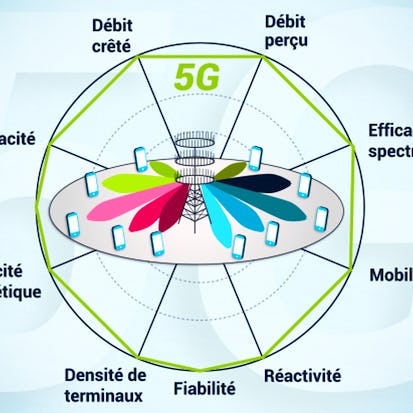- Level Professional
- المدة 19 ساعات hours
- الطبع بواسطة Institut Mines-Télécom
-
Offered by

عن
This MOOC presents the services and the architecture of 5G networks, the main principles of the new radio interface (NR), data flow management, security and the new Service-Based Architecture (SBA). In recent years, operators have been deploying 5G technology on commercial mobile networks. The latter is announced as a major technological breakthrough with speeds beyond Gbit/s, very low latencies and above all a distribution in many sectors of activity (industry, transport, medicine, etc.). Beyond the announcement effects, this technology relies heavily on 4G. The waveform for radio transmission is identical, the management of data flows is similar. However, 5G significantly extends the possible options both in the choice of architectures and in the radio interface configurations as well as in the security mechanisms. All this is explained in the mooc. A certificate of successful completion is awarded by Coursera to learners who succeed in obtaining a mark greater than 50%. This MOOC has received financial support from the Patrick & Lina Drahi Foundation.الوحدات
New on Coursera?
6
Readings
- Navigating Coursera
- Getting help
- Forums overview
- Navigating the Forum
- Post a new publication
- Forum moderation
Meet the team and the other learners
2
Readings
- Meet the Instructors
- Introduce yourself
Course syllabus
2
Readings
- A short story about this MOOC
- Course Organisation
Verified Certificate
3
Readings
- For audit learners only
- Course Grading Policy
- Get a verified certificate of achievement
1.1 - Types of services and required performances (KPI) for 5G
1
Assignment
- M1-L1
2
Videos
- Why a new generation of mobile networks ?
- What are the performance requirements for 5G ?
1
Readings
- Download all the slides
1.2 - Overview of 5G services
1
Assignment
- M1-L2
1
Videos
- What services are provided by 5G ?
1.3 - 5G sub-networks
1
Assignment
- M1-L3
1
Videos
- What are the sub-systems of a 5G Network ?
1.4 - 5G network architecture (main functions and flow management)
1
Assignment
- M1-L4
1
Videos
- What is the architecture of a 5G Network ?
1.5 - Virtualization of network functions
1
Assignment
- M1-L5
1
Videos
- What does virtualization mean for 5G ?
1.6 - Other network functions
1
Assignment
- M1-L6
1
Videos
- Is the 5G architecture really simple ?
Homework
1
Assignment
- Homework M1
2.1 - Frequency Division
1
Assignment
- M2-L1
3
Videos
- Why 5G can offer higher data bit rates ? Part 1 Introduction to the numerologies
- Why 5G can offer higher data bit rates ? Part 2 Numerologies and frequency ranges
- Why 5G can offer higher data bit rates ? Part 3 : Modulations
1
Readings
- Introduction to OFDM
2.2 - Time Division
1
Assignment
- M2-L2
1
Videos
- How is it possible to reduce the latency ?
2.3 - Antenna arrays and beamforming
1
Assignment
- M2-L3
1
Videos
- Is it possible to increase the received power without increasing the transmission power in a mobile communication system ?
1
Readings
- Reminder on Wavelength, frequency and power
2.4 - MIMO Systems
1
Assignment
- M2-L4
1
Videos
- Is it possible to increase the capacity of a mobile networks with antenna arrays ?
2.5 - Protocol Stack on the radio interface
1
Assignment
- M2-L5
1
Videos
- What are the differences between the NR RADIO interface and LTE ?
1
Readings
- Prerequisite
Homework M2
1
Assignment
- Homework M2
3.1- Separation of the control plane and the user plane (CUPS)
2
Assignment
- Prerequesite Quiz
- M3-L1
1
Videos
- How to make the mobile core network more flexible ?
3.2 - PFCP Protocol
1
Assignment
- M3-L2
1
Videos
- How does an SMF control a UPF ?
3.3 - Session establishment with CUPS
1
Assignment
- M3-L3
1
Videos
- How is a PDU session set up in 5G ?
3.4 - Initialization of a terminal in 5G
1
Assignment
- M3-L4
1
Videos
- How does a 5G terminal attach to a 5G Network ?
3.5 - Management of the sporadicity of flows
1
Assignment
- M3-L5
1
Videos
- Is the management of flows that have a sporadic nature the same as in 4G ?
3.6 - RRC-Inactive State
1
Assignment
- M3-L6
1
Videos
- How is a UE managed in the RRC-inactive state ?
1
Readings
- Additional information
3.7 - Mobility and RRC-inactive state
1
Assignment
- M3-L7
1
Videos
- What happens when a UE in RRC-inactive state changes cells ?
1
Readings
- Additional information
Homework
1
Assignment
- Homework M3,
4.1 - Challenges and principles of 5G security
2
Assignment
- Prerequisite quiz
- M4-L1
2
Videos
- Is security really important in 5G ?
- Which aspects of the security procedures should be strenghthened ?
4.2 - Security Architecture
1
Assignment
- M4-L2
1
Videos
- What are the network functions in charge of the security ?
4.3 - The SUCI, a concealed identity
1
Assignment
- M4-L3
1
Videos
- How can we identify a UE without transmitting its permanent identity in clear text over the radio ?
4.4 - Authentication in 5G
1
Assignment
- M4-L4
1
Videos
- What are the differences between 4G and 5G when it comes to authentification ?
4.5 - Key hierarchy
1
Assignment
- M4-L5
2
Videos
- What are the differences between 4G and 5G when it comes to ciphering, integrity control and key hierarchy ?
- What are the security procedures during a registration ?
4.6 - Defense against bidding-down attacks
1
Assignment
- M4-L6
1
Videos
- How 5G is protected against some Bidding down attacks
Appendix: Diffie-Hellman
1
Videos
- How does a Diffie-Hellman work ?
Homework
1
Assignment
- Homework M4
5.1 - SBI, SBA, NF and NF services
1
Assignment
- M5-L1
2
Videos
- What is a Network function ?
- How are the services of an NF organized ?
5.2 - REST and the concept of resource
1
Assignment
- M5-L2
1
Videos
- What is the protocol stack for an SBI ?
5.3 - Operations on a resource
1
Assignment
- M5-L3
1
Videos
- How is it possible to act on a resource ?
5.4 - NF instances and the NRF
1
Assignment
- M5-L4
1
Videos
- How is it possible to have both a dynamic and elastic 5G core network ?
5.5 - Notification service
1
Assignment
- M5-L5
2
Videos
- How does the notification service work ?
- How are the procedures on SBI interfaces presented ?
5.6 - External service provider and NEF
3
Assignment
- M5-L6-1
- M5-L6-2
- M5-L6-3
1
Videos
- How can an external service provider develop its own services using the 5G network ?
Homework
1
Assignment
- Homework, M5
6.1 - Network level security
1
Assignment
- M6-L1
1
Videos
- How is security provided in the radio access network of a 5G system ?
6.2 - Transport level security
1
Assignment
- M6-L2
1
Videos
- How is security provided on SBI interfaces in 5G networks ?
6.3 - Inter-network NF discovery
1
Assignment
- M6-L3
1
Videos
- How is it possible to provide NF Instance discovery service between different 5G networks ?
6.4 - Security between networks (SEPP)
1
Assignment
- M6-L4
1
Videos
- How is security guaranteed between different 5G Networks ?
6.5 - Secure use of NF services
1
Assignment
- M6-L5
1
Videos
- How can security be guaranteed when using services provided by a network function within a 5G core network ? Part 1
6.6 - Secure use of NF services in different networks
1
Assignment
- M6-L6
1
Videos
- How can security be guaranteed when using services provided by a network Between different 5G core networks ? Part 2
Homework
1
Assignment
- Homework, M6
Auto Summary
Dive into the world of 5G with this comprehensive course on 5G Network Fundamentals, designed for IT and Computer Science professionals. Taught by Coursera, it covers 5G services, architecture, NR interface, data flow management, security, and Service-Based Architecture. The course spans 1140 minutes and offers both Starter and Professional subscription options. Ideal for those looking to advance their career in the ever-evolving telecom industry.

Xavier Lagrange


